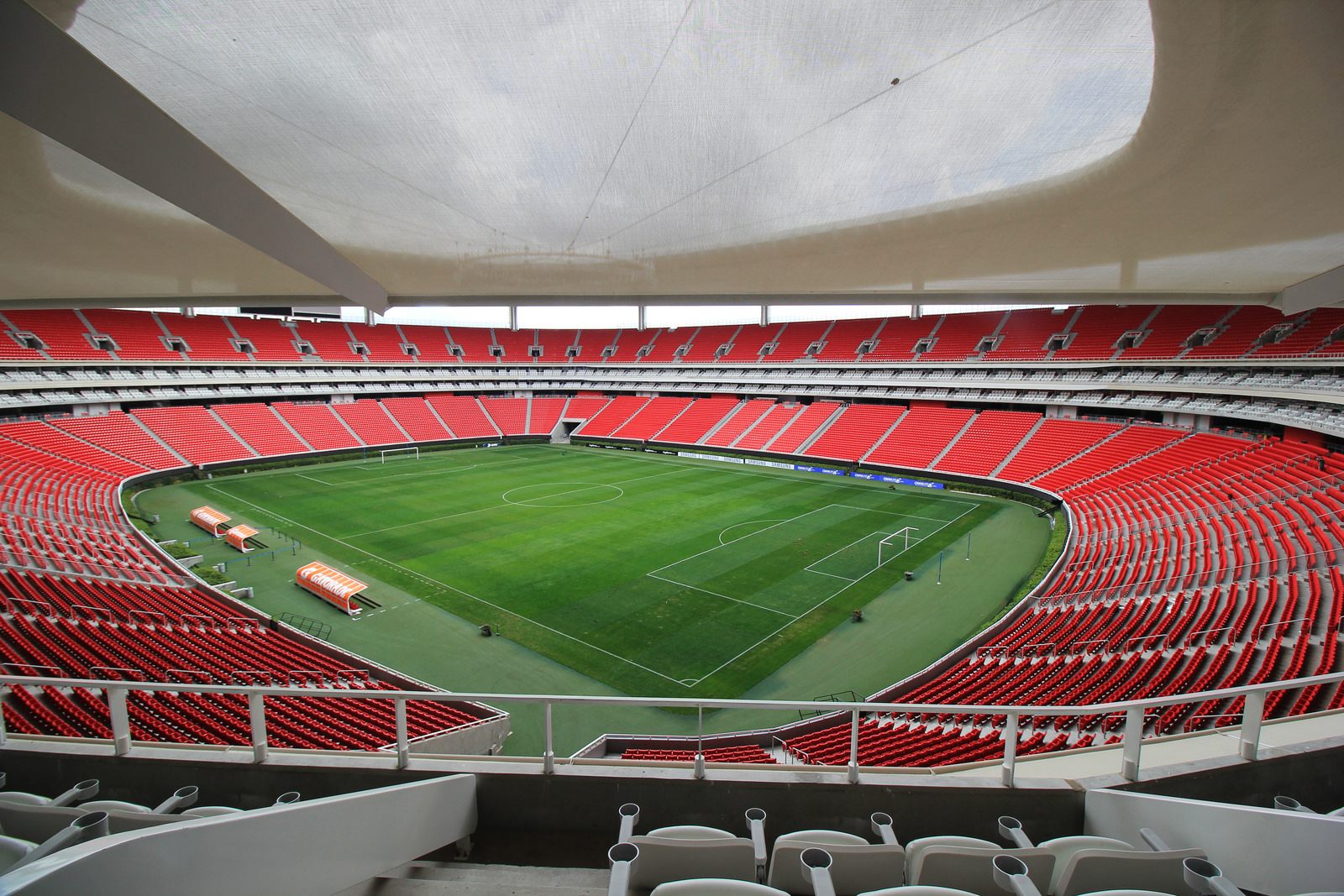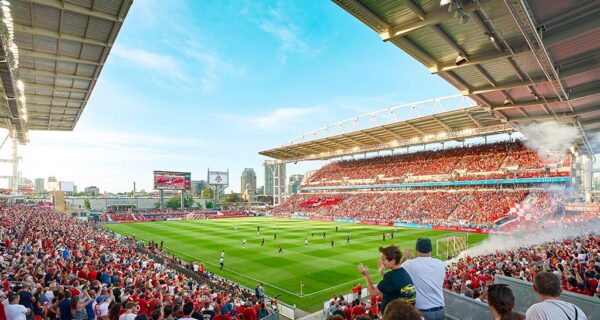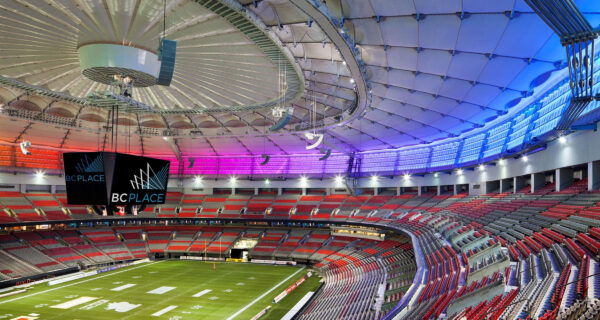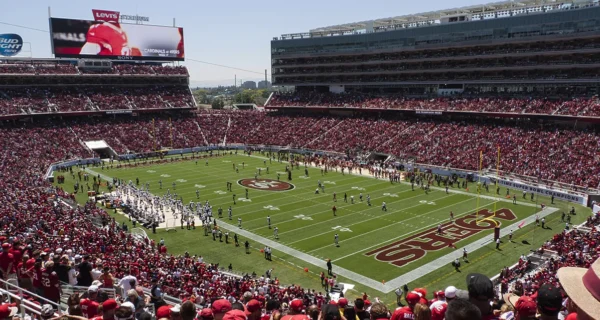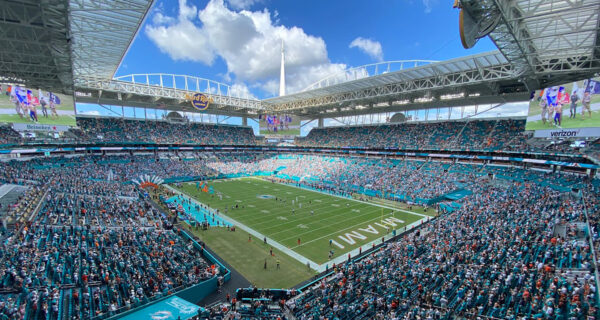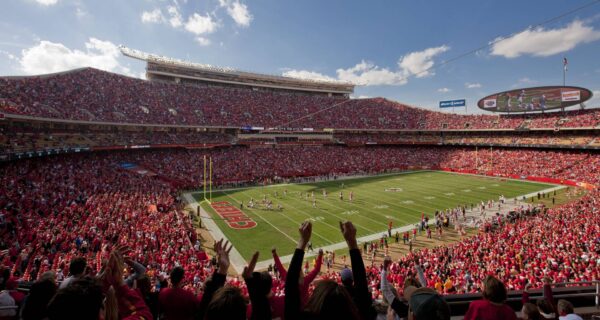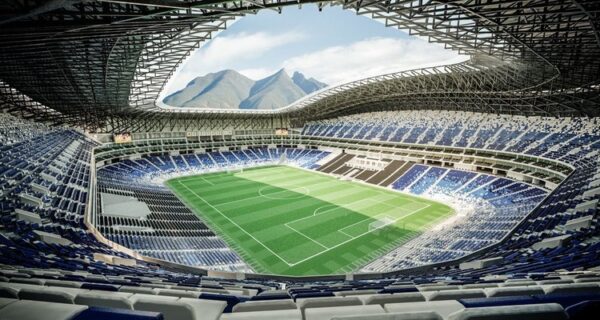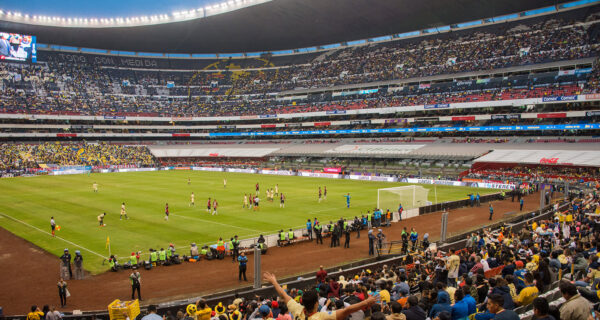This Article Contains
Estadio Akron stands as one of Mexico’s most innovative and architecturally stunning football venues. This modern stadium will soon welcome global football fans as one of the selected venues for the 2026 FIFA World Cup. Located near Guadalajara, this unique volcano-inspired arena offers exceptional viewing experiences and state-of-the-art facilities for spectators and athletes alike.
The stadium combines cutting-edge design with practical functionality, making it a standout destination in North American football. From its remarkable exterior resembling a dormant volcano to its comprehensive amenities, Estadio Akron represents the future of football stadiums in Mexico and beyond. Football enthusiasts eagerly anticipate watching World Cup matches at this distinctive venue.
Estadio Akron Capacity and Seating Arrangements
Total Capacity
Estadio Akron accommodates approximately 49,813 spectators, making it one of Mexico’s larger football venues. This capacity supports major international tournaments like the upcoming FIFA World Cup as well as domestic league matches. The stadium includes standard seating sections plus premium viewing areas for diverse spectator experiences.
The total capacity includes 208 dedicated spaces for disabled spectators, demonstrating the stadium’s commitment to accessibility. For international matches, slight adjustments to the configuration can alter the exact capacity, with some sources citing figures between 48,071 and 49,850 depending on the event requirements.
Executive Suites
The stadium houses 133 executive suites that offer premium viewing experiences and exclusive amenities. These private boxes provide corporate clients and VIP guests with comfortable indoor seating plus exterior seats for direct engagement with the atmosphere. Suite guests enjoy dedicated services not available in general seating areas.
Different suite levels offer varying sizes and amenity packages, with exclusive access to private restrooms, food service, and bars. The CLUB CHIVAS zone receives particularly positive reviews from visitors, who praise its superior views and exclusive facilities. These premium areas generate significant revenue that supports the stadium’s operations.
Seating Layout
Estadio Akron’s seating arrangement follows the standard football stadium configuration with sections numbered systematically. The double-tiered design ensures excellent sightlines from virtually every seat, with many visitors commenting that there are “no bad seats” in the venue. Each section provides clear views of the playing field.
The seating follows a logical organizational pattern where lower numbers in each section typically position closer to adjacent sections. For example, seat 1 in section 5 would sit next to section 4. This systematic approach helps spectators easily locate their designated seats upon entering the appropriate section.
Transportation Options
Public Transit
Several bus lines service Estadio Akron, including routes A12, T02, TALA POR COLÓN, TVT – POR COLÓN, and C109. The T02 line begins service to the stadium as early as 4:35 AM, with the T01 operating as late as 12:04 AM, providing options for both early arrivals and late departures.
The closest bus station sits just 447 meters away, requiring approximately a 7-minute walk to reach the stadium entrance. This proximity makes public transit a practical option for many spectators, particularly those wishing to avoid parking challenges on match days.
Taxi and Rideshare
Taxis offer direct service to Estadio Akron from Guadalajara, typically costing between $7-9 USD for the journey. The ride takes approximately 12-17 minutes depending on traffic conditions and precise starting location. After events, experienced visitors recommend walking to nearby pickup points to avoid congestion.
One recommended strategy involves walking to the Central Camionera de Zapopan (approximately 30 minutes on foot) to secure rideshare services more easily after matches. This approach helps avoid the extreme surge pricing and driver cancellations common in the immediate stadium vicinity following events.
Private Vehicles
The stadium provides parking facilities, though reviews consistently mention traffic congestion following events as a significant challenge. Drivers report bumper-to-bumper traffic lasting considerable time after final whistles, prompting some regular attendees to develop alternative transportation strategies.
Some experienced visitors recommend leaving events slightly early if using private transportation or planning extended post-match activities inside the stadium to allow traffic to dissipate. The distance from central Guadalajara means most visitors must factor transportation considerations into their overall event planning.
Location and Accessibility
Geographic Position
Estadio Akron sits in Zapopan, a municipality adjacent to Guadalajara in the Mexican state of Jalisco. The stadium’s precise coordinates place it at 20°40′54″N 103°27′46″W. This location positions the venue at the outskirts of the Guadalajara metropolitan area, providing sufficient space for its impressive structure and surrounding facilities.
The stadium forms part of the larger JVC complex, integrating sports facilities with commercial and recreational spaces. Many visitors note that the stadium sits somewhat removed from the central Guadalajara area, requiring specific transportation planning. This strategic positioning allows for expansive grounds but necessitates transportation considerations for visitors.
Surrounding Area
The area around Estadio Akron offers limited immediate attractions, focusing primarily on the stadium experience itself. Visitors arriving early can enjoy pre-game festivities in the outer grounds, including food vendors, entertainment, and merchandise opportunities. The surrounding area transforms into a lively hub of activity on match days.
Several reviews mention that the relative isolation from other city attractions means most spectators arrive specifically for events rather than combining their visit with other activities. This dedicated purpose helps manage crowd flow but requires visitors to plan their journey accordingly. The stadium’s distance from downtown creates a distinct football-focused destination.
Architectural Design and Features
Volcano-Inspired Concept
Estadio Akron features a revolutionary design concept inspired by dormant volcanoes native to the Mexican landscape. Architects created a structure resembling a volcanic formation with a grass-covered exterior that blends seamlessly with the natural environment. This volcanic inspiration continues throughout the entire stadium design, creating a unique visual identity.
The stadium consists of three primary elements: an ascending slope covered with natural grass, a steel structure forming the grandstands, and a cloud-like roof resembling volcanic smoke. This distinctive approach to stadium architecture sets Estadio Akron apart from conventional venues, giving it an instantly recognizable profile on the Mexican sporting landscape.
Innovative Structure
The concrete shell forming the stadium’s base received a covering of approximately 70,000 square meters of grass, creating a natural-looking hill that houses the internal structure. This innovative approach to exterior design helps the massive structure integrate harmoniously with its surroundings rather than dominating the landscape with concrete and steel.
Inside, the “crater” features red seating arranged in double-tiered stands, completing the volcanic visual metaphor. The white roof appears to float almost weightlessly above the seating areas, supported by just 16 structural pillars. This engineering feat enhances both aesthetics and functionality, providing excellent coverage without obstructing views.
Design Team
The stadium’s groundbreaking design emerged from collaboration between several architectural firms. VFO architects worked alongside Jean Marie Massaud and Daniel Pouzet on the concept design. Sports architecture specialists Populous (formerly HOK Sport) provided expertise on functional sporting requirements, ensuring the creative vision maintained practical usability.
This international collaboration brought diverse perspectives to the project, resulting in a stadium that successfully balances aesthetic innovation with sporting functionality. The team overcame numerous technical challenges to realize their vision of a volcano-inspired structure that would serve as both a practical venue and architectural landmark.
History and Construction
Development Timeline
Construction on Estadio Akron began in February 2004, following Jorge Vergara’s acquisition of Club Deportivo Guadalajara. The initial groundbreaking marked the start of an ambitious project to create a dedicated home for Chivas. However, financial constraints caused multiple delays throughout the construction process.
Actual construction work accelerated in May 2007, with major structural elements taking shape over the following years. After numerous challenges and delays, the stadium finally reached completion in July 2010, approximately 6.5 years after the project started. This extended timeline reflected both funding issues and the complexity of the architectural vision.
Opening and Inauguration
The stadium officially opened on July 30, 2010, with an inaugural match between Guadalajara and Manchester United. This high-profile friendly attracted global attention, with Guadalajara winning 3-2. The opening celebrated both the new venue and marked Javier Hernández’s transfer from Guadalajara to Manchester United.
In a unique arrangement for the inaugural match, Hernández played the first half representing Guadalajara before switching to Manchester United for the second half. This symbolic transition highlighted the connection between Mexican football and international competition, themes that continue with the stadium’s selection as a 2026 World Cup venue.
Name Changes
The stadium has undergone several name changes throughout its history. Originally referred to simply as “Chivas Stadium” or symbolically as “El Templo Mayor” during construction, it officially opened as Estadio Omnilife, reflecting sponsorship from Vergara’s nutrition company.
In 2016, the name changed to Estadio Chivas before eventually becoming Estadio Akron in 2017 through a naming rights agreement. These transitions reflect the commercial reality of modern stadium operations, where sponsorship deals provide essential revenue streams to support maintenance and operations.
Fan Experience and Amenities
Food and Beverages
Estadio Akron offers diverse food options throughout the concourse areas, ranging from quick snacks to more substantial meals. Vendors also circulate through the seating areas, bringing food and drinks directly to spectators. The stadium serves the popular Mexican beer Corona in generous one-liter pours.
Food prices follow typical stadium pricing models, with premium costs compared to outside establishments. Reviews mention the variety of options available, allowing spectators to sample different Mexican specialties during their visit. Some premium seating areas include dedicated food service with expanded menu offerings.
Facilities and Services
The stadium provides ample restroom facilities throughout all levels, addressing a common pain point at sports venues. Visitors frequently comment positively on the cleanliness and maintenance of these facilities, noting sufficient capacity even during peak usage periods at halftime.
Merchandise stores and booths throughout the stadium offer official team products and souvenirs. Most areas of the stadium provide good cellular coverage and free WiFi connectivity, allowing spectators to share their experience on social media. The modern design incorporates numerous amenities expected in contemporary sports venues.
Safety and Security
Security presence remains visible but unobtrusive throughout events at Estadio Akron. Multiple reviews describe it as “arguably the safest stadium in Mexico,” creating a comfortable environment for visiting supporters and families. Security protocols include standard bag checks and screening procedures upon entry.
The venue features well-marked evacuation routes and clear emergency procedures. The modern design incorporates contemporary safety standards, with wide concourses and multiple exit points facilitating smooth crowd movement. These safety features represent important considerations for international tournament hosting.
FAQs
1. What is the seating capacity of Estadio Akron?
Estadio Akron has a seating capacity of approximately 49,813 for regular events. The stadium features a double-tiered seating arrangement with excellent sightlines from virtually every seat. Small adjustments can modify the exact capacity depending on the specific event requirements and configuration.
3. Where exactly is Estadio Akron located?
Estadio Akron is located in Zapopan, Jalisco, Mexico, just outside the main city of Guadalajara. The precise coordinates are 20°40′54″N 103°27′46″W. The stadium forms part of the JVC complex and sits at the periphery of the Guadalajara metropolitan area.
4. How can I reach Estadio Akron using public transportation?
Several bus routes serve Estadio Akron, including A12, T02, C109, and others. The closest bus station is only 447 meters (a 7-minute walk) from the stadium entrance. Public transportation offers an affordable alternative to taxis and helps avoid parking challenges on match days.
5. What makes Estadio Akron’s design unique?
Estadio Akron features a volcano-inspired design with a grass-covered exterior resembling a natural hill. The interior “crater” contains red seating, while a white “cloud-like” roof appears to float above. This innovative design, created by an international team of architects, seamlessly integrates the large structure with the surrounding landscape.
6. When did Estadio Akron open and how much did it cost to build?
Estadio Akron opened on July 30, 2010, with an inaugural match between Guadalajara and Manchester United. Construction began in February 2004 but faced several delays. The final construction cost reached approximately US$200 million (equivalent to $288 million in 2024 dollars).
7. What other names has Estadio Akron been known by?
The stadium was originally known as Estadio Omnilife from 2010 to 2016, then briefly as Estadio Chivas from 2016 to 2017, before becoming Estadio Akron. During its planning and construction phases, people referred to it as “Chivas Stadium” or symbolically as “El Templo Mayor.”
8. What major events has Estadio Akron hosted?
Estadio Akron has hosted the 2010 Copa Libertadores finals, the 2011 Pan American Games opening and closing ceremonies, matches during the 2011 FIFA U-17 World Cup, and numerous international fixtures featuring the Mexican national team. It will serve as a venue for the 2026 FIFA World Cup.
9. What premium seating options does Estadio Akron offer?
The stadium features 133 executive suites with premium amenities. The CLUB CHIVAS zone receives particularly positive reviews for its superior views, private bathrooms, and exclusive bar access. Various premium sections offer different levels of service and amenities throughout the venue.
10. What food and drink options are available at Estadio Akron?
Estadio Akron offers diverse food options ranging from quick snacks to full meals. The stadium serves Corona beer in generous one-liter pours. Vendors circulate through the seating areas, and concession stands line the concourses. Premium seating areas include dedicated food and beverage service with expanded menu options.

